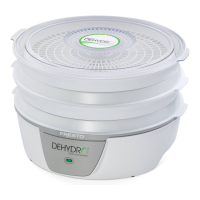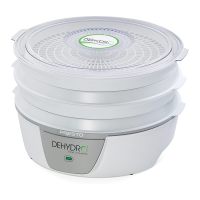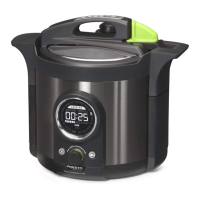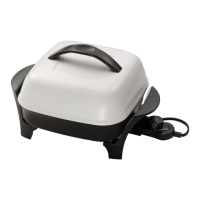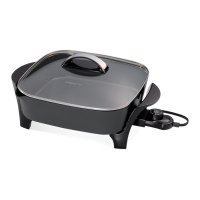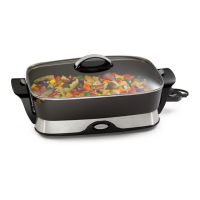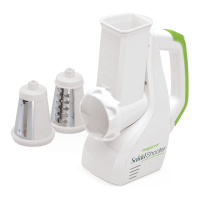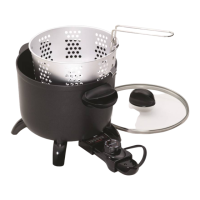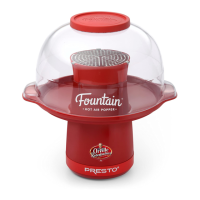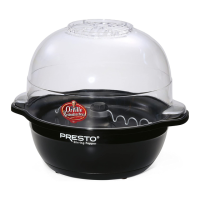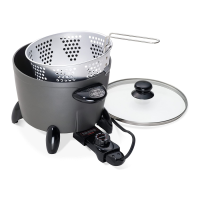8
Pretreatment
The process of blanching involves subjecting vegetables to a high enough temperature to deactivate the enzymes. Blanching is neces-
sary to stop the naturally occurring enzymes from causing loss of color and avor during drying and storage. Blanching also relaxes
the tissue walls so moisture can more readily escape during drying and enter during rehydrating. Blanching can be done in water or
steam. Water blanching causes a greater loss of nutrients but is faster than steam blanching and achieves a more even heat penetration.
Steam blanching—Fill a deep pot with water and bring to a boil. Place vegetables loosely in a basket or colander that will allow
steam to freely circulate around the vegetables. Do not ll basket or colander with more than a 2½-inch layer of vegetables. Position
the basket or colander in the pot, making sure it does not contact the boiling water. Cover with a close tting lid. Steam for the time
indicated in the Vegetable Drying Guide.
Water blanching—Fill a large pot ⅔ full with water. Cover and bring to a boil. Place vegetables loosely in a basket or colander
and submerge in the boiling water. Cover and blanch for the time indicated in the Vegetable Drying Guide. Water should return to a
boil in less than 1 minute. If not, too many vegetables were added to the basket; reduce the amount of vegetables added for the next
batch. Water blanch for the time indicated in the Vegetable Drying Guide.
Immediately after steam or water blanching, dip the vegetables in cold water to quickly cool them. Drain the vegetables and arrange
them in a single layer on the dehydrator trays. Refer to the Vegetable Drying Guide for drying times.
Determining Dryness
Refer to the Vegetable Drying Guide and begin checking the vegetables at the beginning of the average drying time range. Remove a
few pieces of vegetables from each dehydrator tray and allow to cool to room temperature. Test for dryness by breaking the pieces in
half. Most vegetables will be crisp when appropriately dried and will break easily. If vegetables do not break easily, additional drying
time is needed. If vegetables seem to have a lot of moisture remaining, recheck every 1 to 2 hours. If vegetables appear to be almost
done, check again in 30 minutes. Always check vegetables from each tray.
Follow “Packaging and Storing Dried Food” information on page 9.
Vegetable Drying Guide
Drying times are highly variable and dependent on the type and amount of food, thickness, evenness of food pieces, humidity, air temperature, personal preference,
and the age of the plant at the time of harvesting.
Vegetable Preparation
Pretreatment
(blanching)
Average
Drying Time
Asparagus Cut into 1˝ pieces. Water 3½–4½ minutes
Steam 4–5 minutes
5–7 hours
Beans,
green or wax
Remove ends and strings. Cut into
1˝ pieces.
Water 2 minutes
Steam 2–2½ minutes
5–10 hours
Beets Cook until tender. Cool and peel. Cut into
shoestring strips ⅛˝ thick.
None—Already cooked 3–6 hours
Broccoli Cut into serving pieces. Water 2 minutes
Steam 3–3½ minutes
3–7 hours
Carrots Peel and cut off ends. Cut into ⅛˝ to
¼˝ slices.
Water 3 minutes
Steam 3–3½ minutes
3–9 hours
Cauliower Cut into serving pieces. Water 3–4 minutes
Steam 4–5 minutes
4–7 hours
Celery Trim ends. Cut into ¼˝ slices. Water 2 minutes
Steam 2 minutes
2–4 hours
Corn, cut Husk and remove silk. Blanch and cut
corn from cob.
Water 1½ minutes
Steam 2–2½ minutes
6–10 hours
Mushrooms Wash and slice ⅜˝ thick. None 2–6 hours
Onions Remove outer skin. Cut off top and root
ends. Cut into ¼˝ slices.
None 2–6 hours
Peas Shell. Water 2 minutes
Steam 3 minutes
4–8 hours
Peppers and
pimientos
Remove stem, core, and inner partitions.
Cut into ¼˝ strips.
None 5–9 hours
Potatoes Peel and cut into ¼˝ slices. Water 5–6 minutes
Steam 6–8 minutes
3–7 hours
